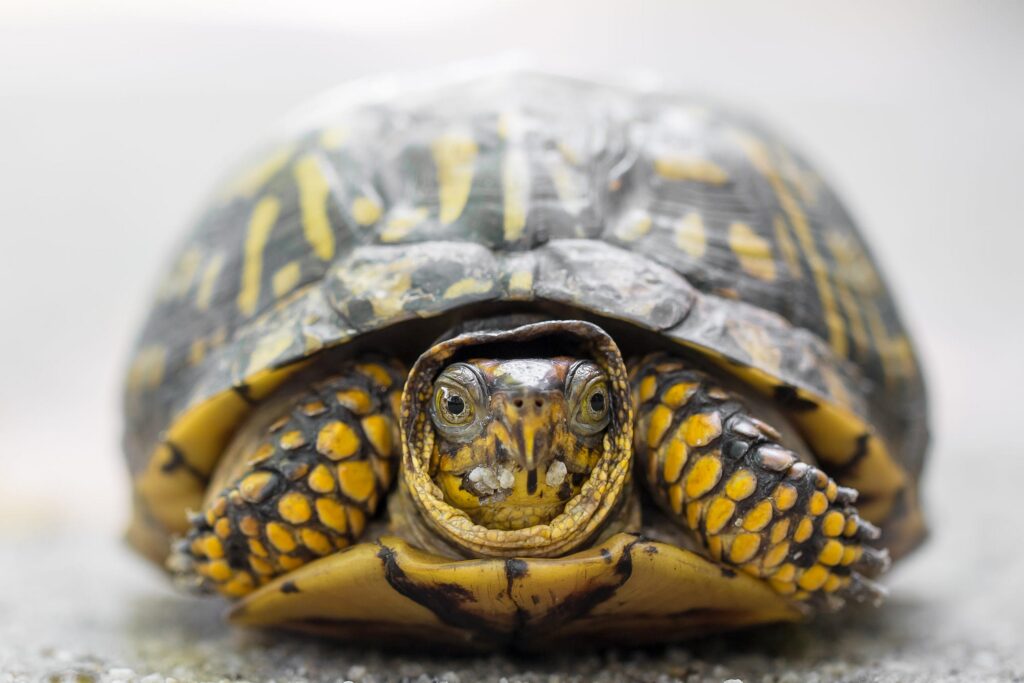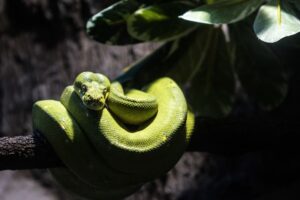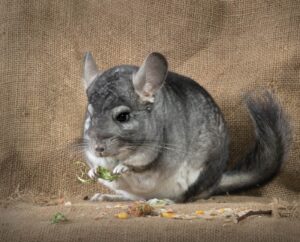Table of Contents
ToggleIntroduction

Box turtles’ eating preferences are an intriguing part of their behavior, molded by their ecological environment and evolutionary history. Do Box Turtles Eat Tomatoes? Tomatoes, a staple in human diets, captivate with their brilliant colors and varied flavors. This examination dives into box turtle ecology, behavior, and the subtle balance between herbivorous and omnivorous tendencies. Going beyond a simple inquiry into their culinary habits. Understanding the role tomatoes may play in the diet of box turtles throws light on their adaptability to different food sources and the symbiotic relationships that define their habitats.
Box Turtle Dietary Behavior
Overview of Box Turtle Omnivorous Tendencies: Box turtles, belonging to the genus Terrapene, are renowned for their omnivorous tendencies. Showcasing a diverse palate that allows them to thrive in various environments. This omnivory distinguishes them from other turtle species and contributes to their adaptability as opportunistic feeders. The ability to consume animal and plant matter allows box turtles to capitalize on the availability of resources in their surroundings. Making them well-suited to various habitats.
Primary Components of Their Diet (Vegetation, Fruits, Insects): Box turtles’ dietary preferences encompass various food sources, emphasizing their versatility as foragers. Vegetation forms a significant portion of their diet, and they are inclined to consume leaves, grasses, and wildflowers. Additionally, fruits, such as berries and other fleshy plants, contribute essential nutrients and hydration to their diet. Box turtles also display an appetite for insects, worms, and other small invertebrates. Adding a protein component to their omnivorous diet. This diverse array of dietary components allows box turtles to meet their nutritional needs across different seasons and environments.
Relevance of Dietary Adaptability to Survival in Diverse Habitats: Box turtles’ adaptability to diverse habitats is intertwined with one another to their dietary flexibility. Box turtles can exploit the available resources, whether inhabiting woodlands, grasslands, or meadows. Switching between vegetation, fruits, and insects enables them to survive fluctuations in food availability and environmental conditions. This dietary adaptability is a key factor in their success as a species, allowing them to navigate a variety of ecosystems with different flora and fauna.
The Culinary Palette Of Box Turtles
Investigation into the Inclusion of Tomatoes in Their Diet: The culinary preferences of box turtles extend beyond the conventional as we investigate whether these reptiles include tomatoes in their diet. Tomatoes, a widely cultivated fruit, present a spectrum of flavors and nutritional components. Observational studies and anecdotal evidence suggest that box turtles consume tomatoes when available. It raises questions about the factors influencing their dietary choices, such as environmental cues, taste preferences, and nutritional requirements. The investigation into including tomatoes in the box turtle diet unveils a fascinating aspect of their culinary repertoire. Shedding light on their adaptability to diverse food sources.
Nutritional Benefits of Tomatoes for Box Turtles: Tomatoes offer a bounty of nutritional benefits that may contribute to overall health and well-being. Rich in vitamins, particularly vitamin C and vitamin A, tomatoes provide essential antioxidants that support immune function and vision. The fruit also contains dietary fiber, promoting digestive health, and minerals such as potassium. Crucial for maintaining proper hydration and electrolyte balance. Understanding the nutritional benefits of tomatoes for box turtles adds depth to our comprehension of their dietary requirements and the potential role of varied food sources in sustaining their health.
Consideration of Dietary Variety and Health Implications: Including tomatoes in the culinary palette of box turtles prompts consideration of the broader implications for their health and dietary variety. A diverse diet is often associated with enhanced well-being, as it ensures a balance of essential nutrients. The ability of box turtles to incorporate tomatoes into their diet demonstrates their adaptability and capacity to glean nutritional benefits from various food sources. However, it also highlights the importance of understanding the dietary variety required for optimal health.
Ecological Implications
Role of Box Turtles as Seed Dispersers: in their omnivorous foraging, Box turtles inadvertently play a crucial role as seed dispersers within their ecosystems. As they roam through diverse habitats, box turtles consume various plant material, including fruits. The seeds within these fruits often pass through the digestive system of the turtles unharmed. This seed ingestion and subsequent deposition in different locations contribute to the dispersal of plant seeds. In essence, box turtles function as unwitting gardeners, aiding in the movement and distribution of plant species across their habitats.
Potential Impact on Tomato Seed Dispersion in Ecosystems: The ecological implications of box turtles consuming tomatoes extend beyond their individual dietary choices to the potential impact on tomato seed dispersion. Tomatoes, being cultivated fruits, may contain seeds that, when ingested by box turtles, are transported to new locations through their digestive processes. This unintentional seed dispersal can influence the distribution and abundance of tomato plants in the wild. Understanding the role of box turtles in tomato seed dispersion provides insights into the complex dynamics of plant propagation and ecosystem diversity. It also raises questions about the interaction between cultivated and wild plant species within box turtle habitats.
Broader Insights into the Interconnectedness of Species within Habitats: The inadvertent role of box turtles in seed dispersal underscores the more general interconnectedness of species within habitats. As these reptiles move through diverse environments. They contribute to the spatial patterns of plant communities, influencing the composition and structure of ecosystems. The interconnected web of relationships extends beyond the immediate interactions between turtles and plants. Affecting other species dependent on these plants for habitat and sustenance. This dynamic interplay reinforces the idea that every species, no matter how seemingly inconspicuous. Plays a role in shaping the ecological fabric of its environment.
Human Impact And Conservation
Consideration of Human Influence on Box Turtle Habitats: The habitats of box turtles are increasingly influenced by human activities. Introducing challenges and opportunities for these resilient reptiles. Urbanization, agricultural expansion, and infrastructure development contribute to habitat fragmentation and loss. Human presence also brings potential disturbances, such as road mortality and encounters with domestic pets. The alteration of natural landscapes by human activities poses a considerable threat to the survival of box turtles. Impacting their ability to forage, reproduce, and navigate through their habitats.
Reflection on Encroachment and Introduction of Non-Native Plants: The encroachment of human activities often introduces non-native plants into box turtle habitats. These invasive species can outcompete native vegetation, altering the composition and structure of ecosystems. For box turtles, this may impact their dietary choices and the availability of familiar food sources. Furthermore, introducing non-native plants may influence the nutritional quality of their diet and potentially alter their role as seed dispersers. Understanding the repercussions of non-native plant introduction provides valuable insights into the complex interplay between human activities and the ecological dynamics of box turtle habitats.
Implications for Conservation Efforts and Biodiversity Preservation: The considerations of human impact on box turtle habitats and the consequences of non-native plant introduction highlight the urgent need for conservation efforts and biodiversity preservation. Conservation initiatives should address habitat protection, restoration, and management strategies that mitigate the negative effects of human activities. Encouraging responsible land use, creating wildlife corridors, and implementing measures to reduce road mortality are integral to conservation efforts to preserve box turtle populations.
Conclusion
Our research indicated that box turtles, known for their versatility, take tomatoes as part of their diversified diet. While their primary diet consists of flora, fruits, and insects, adding tomatoes complicates their omnivorous tendencies. The nutritional benefits of tomatoes, which are high in vitamins and antioxidants, help to box turtles’ general health and well-being. Adapting to various food sources demonstrates box turtles’ resilience and capacity to flourish in multiple settings.
Beyond box turtles’ individual feeding preferences, our investigation prompted us to investigate the ecological consequences of their interactions with tomatoes. Box turtles, being omnivores, play an important role in seed distribution, potentially helping to spread tomato seeds throughout their ecosystems.







